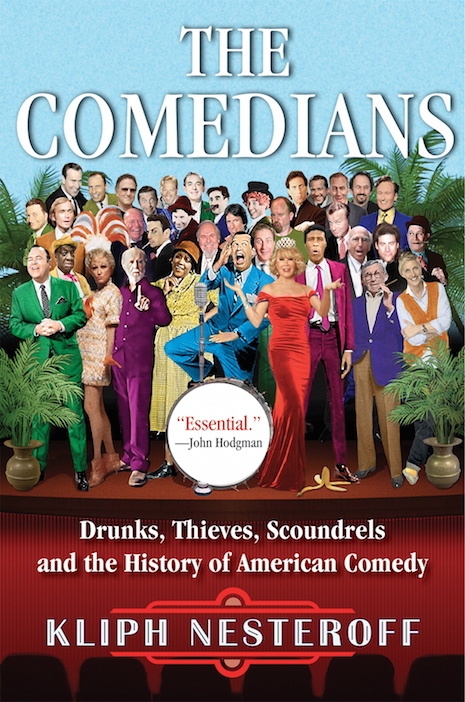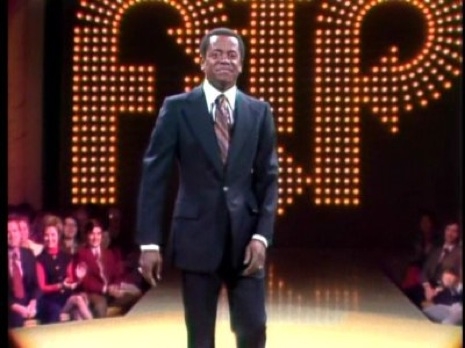
I’ve been aware of Kliph Nesteroff’s singular erudition for a number of years now. Sometime in 2008 WFMU’s incredible Beware of the Blog (which sadly stopped operating earlier this year) ran a loooong article about the early years of George Carlin—which is to say, focusing on the years before the 1967 release of Carlin’s first solo album Take-Offs and Put-Ons, an era that most readers probably had hardly any notion about. After a while came similar articles dedicated to the early years of Woody Allen and David Letterman, both of which were similarly informative. All of these articles carried the cryptic byline “Listener Kliph Nesteroff,” which seemed random enough and lent the impression that the author was perhaps a housebound retiree, former Navy during the Korean War, something like that.
How happy for us readers—as the news may portend further publications down the road—to learn that Kliph is far from a grouchy old obsessive, but rather a charming young obsessive (well, maybe a little grouchy), who for some reason has acquired a taste for unearthing and preserving invaluable scuttlebutt from the early days of comedy. For years he has run an essential blog called Classic Television Showbiz and an amusing Tumblr called Showbiz Imagery and Chicanery. The former houses his long-form interviews with some of the important figures of midcentury comedy (many on the verge of being forgotten today), including Orson Bean, George Schlatter, Peter Marshall, a category that also includes an incredible eight-part interview with Jack Carter. Showbiz Imagery and Chicanery is every bit as entrancing, consisting mostly of context-free screen shots of puzzling images and text culled from the hours Kliph spends with the inexhaustible (and expensive! do donate!) resource known as the Variety.com archives.
Suffice to say, in a few short years Kliph has put together a knowledge base on the roots of stand-up comedy that dwarfs that of anyone younger than, say, 50. By dint of curiosity and hard work, Kliph put himself into a position where he could see the linkages between the present and the past, could isolate the ways in which the patterns that structure the industry of professional comedy found their origins not necessarily in the ersatz “comedy boom” of the 1980s but in practices that stretch much further back.
It was incumbent upon Kliph, then, to write a book about all of this, and thank goodness, that’s precisely what he’s done. Next week sees the publication of The Comedians: Drunks, Thieves, Scoundrels, and the History of American Comedy, and I can say with confidence that this book will be an invaluable resource for decades to come, for anyone who wants to know about the full history of comedy, stuff that predates the days when Robin Williams was saying “Nanu Nanu” on national TV. Something very similar happened in baseball a generation or two ago, when a writer named Lawrence Ritter decided to hunt down as many players as he could find from the early days of baseball (around 1900)—those interviews eventually became a book called The Glory of Our Times, which was published in 1966 and had a massive impact on the way the sport’s fans regarded the heroes of prior generations. The highest compliment I can pay Kliph’s new book The Comedians (which is available for pre-order right now) is that I think he may just have written comedy’s analogue to The Glory of Our Times, the book that—if you have not absorbed its contents—all but demands that you hold your tongue on the subject of old-time comedy.
Kliph graciously set aside some time to answer some questions from DM.
You’ve discovered a whole new area of research to mine, at least for people of our generation. Soon it will just be called “Kliphland.” How did you get started investigating the midcentury era of comedians?
Kliph Nesteroff: As a teenager I was your typical hipster scum, collecting vinyl records and raiding local thrift stores. I collected soul music, garage rock, surf music - and comedy records. The comedy LPs were by far the most worthless. I would see the same comedy records in every junk pile: Rusty Warren, Woody Woodbury, The First Family featuring Vaughn Meader.

I was already interested in comedy but had never heard of these people. Why were they in every thrift store but never on TV or in movies? They must have been super popular at one point if their records were everywhere, right? So that made me sort of curious. Then I learned that after Vaughn Meader had the best-selling record of all time (not just comedy, but any LP period) he went crazy, schizophrenic, destitution, eating out of dumpsters, eventually wandering the desert on peyote before turning Christian and reinventing himself as a local country and western performer in Maine. Clearly there was a worthwhile story there.
I was already a writer and started stand-up at the age of 18. So, I guess the subject matter was just a natural combination of interests. The creative freedom Ken Freedman provided at WFMU allowed me to experiment and write on any topic of my choosing.
The kids in the audience at the UCB Theater probably have no idea that they’re enthused about an art form that was more or less invented by the Mob. You write that pretty much all comedians after Prohibition were working by the grace of one or another group of gangsters. That must have been hard!
Kliph Nesteroff: No, I wouldn’t say the Mafia invented the art form. In my book I have an anecdote from a 90-year-old comedian who argues they coined the phrase “stand-up comic,” because the Mob managed boxers they called “stand-up fighters” and called people they could rely on “stand-up guys.” But no, the Mob had nothing to do with inventing it. They simply owned 90% of the venues where comedians performed from the 1930s through the mid-1960s. So, you know, make the wrong wisecrack and you might suffer a broken limb.
You’ve spent a lot of time lately hanging out with some of the now-forgotten stand ups of the 1950s, who are now getting pretty old and crotchety too. They’ve been treating you pretty well, but they’ve probably been difficult at times too. Any stories to pass along?
Kliph Nesteroff: I don’t know. Old people get angry sometimes. I guess we would too if we had trouble peeing. Carl Reiner is considered the epitome of clean comedy, a guy who can write divinely funny scripts without cussing. I was at a Dick Van Dyke tribute once. I went to the bathroom and was at the second urinal when someone came in and went to the first urinal right beside me. It was a 90-year-old Carl Reiner. He braced himself with his left hand against the wall and the whole time he was at the urinal grumbling, “Goddamit Fuck! Come on! Go! Go! Just go! Jesus fucking bullshit, come on! Fucking goddamn fuck!”
You’ve unearthed so much valuable information about pioneers who helped forge comedy archetypes we all take for granted now, like Frank Fay and Jerry Lester. It must have been fun to spot and explain connections between, say, Bert Williams and Jim Gaffigan.
Kliph Nesteroff: Well, mapping the connections that haven’t been connected before is a little bit like playing God. Based on the reviews coming in, it sounds like I’ve laid down some kind of masterwork, a sacrosanct history of comedy, and that’s extremely flattering and gratifying - but wasn’t my intention at all. I was just writing whatever I felt was interesting. Comparing Jim Gaffigan’s under-the-breath comments to a similar gimmick the vaudeville comic Bert Williams utilized is just an easy point of reference to help the reader get it. Sort of the way lazy film critics explain new movies: “It’s Revenge of the Nerds meets Schindler’s List!”

It was interesting to read about Carlin’s drug use in such detail. I didn’t realize how central LSD was to his reinvention in the late ‘60s.
Kliph Nesteroff: George Carlin, Richard Pryor and Lily Tomlin are considered the three revolutionary figures of comedy from that time. All three were primarily into cocaine in the 1970s, but before that Carlin and Pryor used LSD to positive effect. I think we as a society, y’know, as we hear The Beatles piped through at the local grocery store… we forget just how valuable psychedelics have been to expanding the artist’s inherent ability. Carlin and Pryor would have been fine talents regardless, they were born with that. But it’s because of their 1960s LSD use that their perspectives were forever altered, and why so many today consider them comic geniuses. LSD and other psychedelics can help our latent talents fuse new, uncharted neuro pathways and in turn create an original artistic temperament, unique perspective, prolific output. Groundbreaking revelations come from these experiences and they don’t wear off like a hallucination. Instead you possess new insight that will further your existing artistic ability. I mean, it’s hardly news that LSD is responsible for countless Aphrodites in music, illustration, filmmaking… But maybe the new news, as I argue in my book, is that it had the same important effect on comedy. If such theories are accepted, it’s usually in reference to the 1960s. Let’s not forget that it can still be used with the same revelatory intent today. To quote George Carlin: “More people should do acid.”

Flip Wilson was a huge deal in the 1970s, but he’s practically forgotten now. Can you describe his importance to the comedy counterculture?
Kliph Nesteroff: It’s mostly tangential. He was an early employer for Richard Pryor and George Carlin, using them as writers, and bankrolled Carlin’s best-selling comedy LPs. Flip Wilson’s significance was less on the counterculture than the mainstream. He was the very first African-American with a major network success of his own. You could argue Cosby with I Spy, but Cosby only costarred. Flip Wilson was the star of his own show… an African-American cokehead who had the number one comedy program in America. Think about that. Ten years earlier, Sammy Davis Jr, a guy who loved Sinatra’s racist jokes and endorsed Richard Nixon, could not get a sponsor for his own variety show because he was Black. Just a few years later and Flip Wilson was on the cover of every conceivable magazine. It’s incredible how quickly America changed. And despite the lunatics saying abhorrent things on cable news today, I think we’re experiencing another rapid paradigm shift akin to that era. Never in my lifetime did I expect to see gay marriage, marijuana legalization or a Black president. Nor could I ever imagine that Bernie Sanders would be a household name. Jerry Seinfeld kvetching about political correctness is not too far from Bob Hope complaining about hippie protestors. America is changing, brother. Sure, everything could dissipate like Jerry Rubin turning into a Wall Street powerbroker, but I think we’re only entering the Abbie Hoffman phase of this new era.
Order Kliph Nesteroff’s The Comedians: Drunks, Thieves, Scoundrels, and the History of American Comedy from Amazon.
Previously on Dangerous Minds:
Hitler’s home movies, starring Mel Brooks (with a young David Letterman), 1978
Short-haired George Carlin on ‘What’s My Line?’ in 1969






